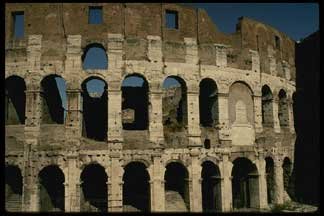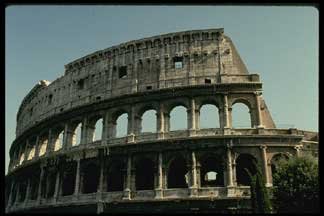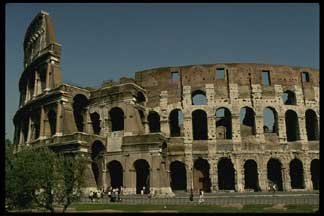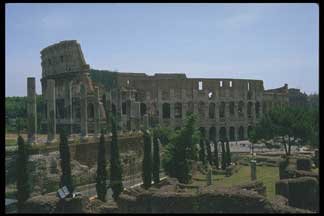The Roman Coliseum
 The
building of the Roman Coliseum (Colosseum) was begun in 72 A.D. by Emperor Vespasian.
Emperor Titus added a forth tier and dedicated the amphitheater in 80 A.D. The
dedication ceremony included the slaughtering of 5,000 animals. That was followed
by 100 days of games. The amphitheater took on the name Flavian Amphitheater
after the ruling dynasty's family name. It was named in the middle ages The
"Colosseum" after a large statue of Nero which used to stand beside
it.
The
building of the Roman Coliseum (Colosseum) was begun in 72 A.D. by Emperor Vespasian.
Emperor Titus added a forth tier and dedicated the amphitheater in 80 A.D. The
dedication ceremony included the slaughtering of 5,000 animals. That was followed
by 100 days of games. The amphitheater took on the name Flavian Amphitheater
after the ruling dynasty's family name. It was named in the middle ages The
"Colosseum" after a large statue of Nero which used to stand beside
it. 
The Amphitheater is 465 feet long, 386 feet wide and 118 feet high. The foundation of cement measures 23 feet thick. The building was built on the site of an artificial lake which had to be drained. Some of those drains are still in use today. (If those drains were closed the amphitheater could be flooded for mock sea battles) The exterior was made up of three tiers of arches. The first set of arches were Doric, the second Ionic, and the third were Corinthian. The amphitheater was equipped with 240 masts. On the masts a large canvas would be attached which could be extended to protect the audience from the elements.
 The
seating in the Coliseum was divided by classes. The Imperial court were in the
lower tier. Behind them the aristocratic families. The next set of seats were
occupied by the commoners. Finally, women, were seated at the very top tier.
From most accounts very few women attended the events.
The
seating in the Coliseum was divided by classes. The Imperial court were in the
lower tier. Behind them the aristocratic families. The next set of seats were
occupied by the commoners. Finally, women, were seated at the very top tier.
From most accounts very few women attended the events.
Gladiator fights were outlawed
in 438 A.D. and the last animal show was in 523 A.D. Part of the wall of the
Coliseum was destroyed by an earthquake. The Coliseum fell into disrepair. It
was scavenged for materials for use in St. Peters, Palazzo Venezia, Palazzo Barberini, and
Plazzo Farnese. Pope Benedict XIV finally stopped the looting of the arena in
1744 when he made the site a holy site.
for materials for use in St. Peters, Palazzo Venezia, Palazzo Barberini, and
Plazzo Farnese. Pope Benedict XIV finally stopped the looting of the arena in
1744 when he made the site a holy site.
Source:
Tim Jepson, (2001). Fodor's Exploring Rome. Fodor's Travel Publications. New
York, New York.
City of Rome | Circus Maximus | Roman Coliseum | Coliseum #2 | Entertainment at Coliseum
Enterainment in Rome | Roman Forum | Roman Theaters

